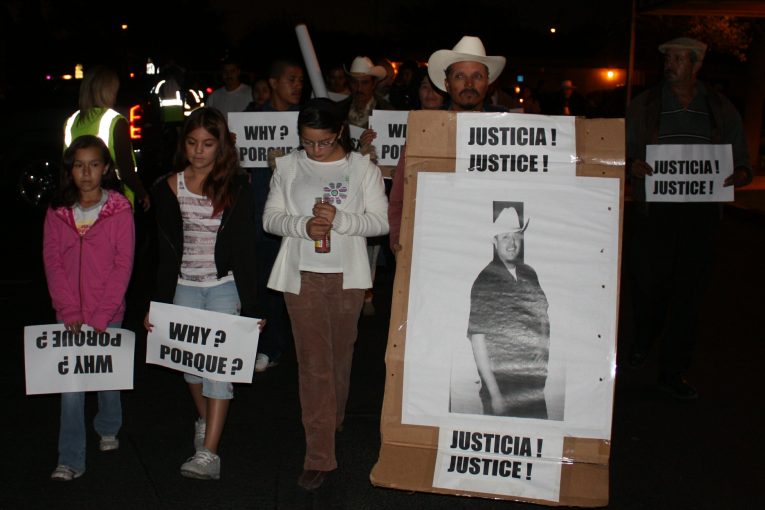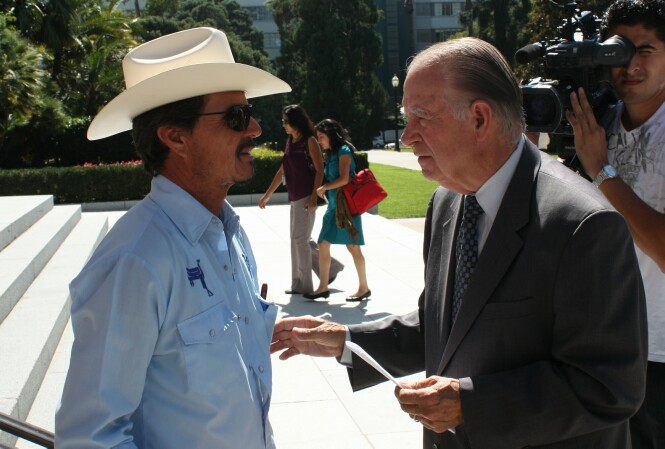

(Editor’s note: this column was published January 13, 2015, and republished after the passing of former Justice Cruz Reynoso on Friday)
By Cruz Reynoso
As we saw in Ferguson, Mo., and we have seen in Yolo County, procedures used by district attorneys raise more questions than answers in incidents of police shooting. Any killing of a fellow human being demands the attention of our society.
No peace officer goes to work each day thinking that he or she will be involved in a shooting in which a fellow human being dies. Yet it happens. Sometime it is justified, as when the officer’s life is in danger. Sometimes it is not justified when the cause is prejudice or poor training. Or it may be poor judgment by an otherwise exemplary officer. Not infrequently, the officer is traumatized by the unexpected incident.
Such a killing took place in Yolo County more than five years ago on the afternoon of April 30, 2009. Luis Gutierrez, an immigrant farm worker, was shot in the back by members of the Yolo County Gang Task Force. Members of the Chicano/Latino community marched and rallied in protest; hundreds of family and friends attended the funeral.
The district attorney issued a report on Sept. 9, 2009. It did not decrease what The Daily Democrat in Woodland described as “ill will” between the Latino community and law enforcement.
A citizens committee, representing various concerned groups that composed the Justice Coalition, had come to see me before the district attorney issued his report. The report raised more questions than answers. I agreed to chair an independent Civil Rights Commission composed of interested citizens, including a retired police officer and a former prosecutor.
With resources from two foundations, we held hearings regarding the killings, and worked with an investigator. We plan two more activities: holding hearings from gang experts on effective responses by communities that suffer from gang activity and publishing a detailed report about the Gutierrez killings and making recommendations.
What questions and concerns were raised by our hearings and investigation? Was the District Attorney’s Office truly independent? The district attorney had established the Yolo County Gang Task Force. He later turned it over to the county sheriff. His investigators were active in the probe. We had access to the videotaped interviews and reports made by the police, which we were able to obtain from the attorneys representing the Gutierrez family in a civil suit.
Should the investigation have been turned over to an agency that did not have interest in the well-being of the Yolo County Gang Task Force?

Here’s what happened
What happened is as follows: Gutierrez was walking home from the office of the Department of Motor Vehicles when an unmarked black Ford Taurus traveling west stopped suddenly in front of him, on East Gum Avenue in Woodland. The men were dressed in civilian clothes.
One man quickly exited the vehicle. Gutierrez ran immediately. The men were officers, members of the Yolo County Gang Task Force. Sgt. Johnson, the one who exited quickly, said in the taped interview that he showed Gutierrez his badge that was on his belt, and the district attorney’s report refers to this attempted conversation as a “consensual encounter.”
However, the U.S. Supreme Court has ruled that if an officer shows his authority, the encounter cannot be considered “consensual.” And if the encounter is consensual, the person can decline the encounter or terminate it at will.
Why does the district attorney’s report not deal with this issue? Did the circumstance of the sudden stop by plain-clothes men driving a large black car frighten Gutierrez, causing him to run? If the encounter was consensual, did Gutierrez not have the right to not participate and did nothing wrong by running?
Gutierrez ran with Johnson in pursuit, gun in hand. The U.S. Supreme Court has ruled that an officer violates the Constitution if he or she shoots to death a fleeing felon. That is, the officer may not act as accuser, judge and executor.
Why was Johnson pursuing a person, not known to have violated any law, with gun to the ready? Johnson reported that when he was running, Gutierrez had his right hand in his pocket or in and out of his pocket. Several witnesses we talked to or who testified before our commission observed Gutierrez running fast, swinging his arms as he ran, and not having his right hand in his pocket. Who is correct?
A struggle, then a shot
Gutierrez ran southward, and Johnson caught up with him. According to the district attorney’s report, the sergeant attempted to grab Gutierrez but he evaded his grasp. However, a witness testified that a short but violent struggle took place wherein Johnson received one or more serious blows to his face. Who is correct? If the blows were exchanged, it may be material in explaining the mind-set when shots were fired later.
Gutierrez then ran toward the opposite side of the street, near where he had started. His run took him a few feet from the witness. She describes Gutierrez as being in extreme fright. He turned and ran northerly. By that time, Deputy Oviedo had joined the chase. Gutierrez was cornered. According to the district attorney’s report, Gutierrez pulled his knife from his pocket and attempted “to either stab or slash” Sgt. Johnson, who “immediately jumped backwards,” and drew his gun and fired.
In fact, in his taped interviews, which we saw, Johnson says he made his body into a “C” shape to avoid the knife, but also states that he and Oviedo, who also fired, were a “car length” from Gutierrez when they shot, and that Oviedo was behind Johnson. Is that important in assessing whether Johnson’s life was in danger?
None of the witnesses who saw the incident saw the knife reported by the two officers. One such witness testified before the commission, and others talked with our investigator. Most of the eyewitnesses are not mentioned in the district attorney’s report.
Deputy Bautista, the third member of the Gang Task Force who was driving the car, said in his video-recorded interview that he did not see or hear the shooting, and thus did not see a knife. Where does the truth lie? Was the D.A.’s Office simply incapable of finding those witnesses? Are they correct or are the deputies correct?
Fair treatment for all
The president of the University of California appointed me a chair of the task force that investigated the Nov. 18, 2011, pepper-spray incident at the UC Davis campus. I met with many experts. One told me that he is hired by police departments to do evaluations; of the 50 to 60 such departments that hired him he said only one met the standard, in his judgment, that all should meet.
That standard requires that all citizens be treated the same, citizens or fellow officers. He explained that his evaluations found that officers protect one another even when an officer violates the law, and they would not do so for a citizen who is not a police officer. Could that be true of the Yolo County deputies five years ago?
Is a scenario out of the question that imagines that Gutierrez, thinking the men were gang members, ran as fast as he could, fought one off in a short but vicious fight, was cornered, and the officers, in high emotions, used poor judgment and shot Gutierrez, meaning to subdue him? Their fellow officer, not involved in shooting, was reluctant to tell what he saw.
The case has come to an end. The D.A.’s Office indicated it was asking both the state Attorney General’s Office and a federal agency to investigate the matter. Later, the D.A.’s Office claimed to have been cleared by both agencies. In fact, no investigation was done by either agency.
I spoke with the attorney for the state Attorney General’s Office who told me that, based only on the district attorney’s report, she found no abuse of discretion. The Civil Rights Commission also asked the state attorney general and the federal government to do an independent investigation in light of the many questions raised by the D.A.’s report. No such investigation has taken place. Thus, in my view, no truly independent investigation has been undertaken.
People want the facts
There are alternatives. Many years ago, as a private attorney in El Centro, I represented a family of a Latino young man who was shot to death by a white police officer. The Latino community was up in arms. In a small town, one knows many of its residents. I knew the young white police officer, who was a good person.
The coroner decided to have a public inquest as to the cause of death. I requested and was permitted to participate in the inquest, including cross-examining the witnesses. The witnesses included the white officer.
What had taken place was clear: The young man was arrested at night in a bar but was left alone near the police car and was asked not to leave while another arrest was made. He ran. The officer gave chase.
The young man ran to an alley and then into a small alley connected to the main alley. The small alley light was out and the small alley was pitch-dark. The young police officer testified that he.saw the police car drive slowly in the main alley a few feet away. He did not call for backup but proceeded to try to make the arrest. A struggle ensued and the young Latino was killed.
What became clear was that the officer used poor judgment, but the death was not based on prejudice. The family and the community knew exactly what had happened. The Latino community accepted the findings and the family decided not to bring suit against the city.
What families and the community want to know is what actually happened. It is a disservice to have procedures that leave too many questions unanswered, as happened in Ferguson, Mo., in the case of Michael Brown’s death and in Yolo County in the case of Luis Gutierrez’s death.
Police experts have suggested that society places too heavy a responsibility on police officers who must deal with mentally disturbed people, situations of domestic violence and other cases that social-service agencies might be better equipped to handle.
Other experts have suggested that local district attorneys work too closely with local police to expect an unbiased report; rather, a third independent agency must undertake that task.
As one writer has put it: “We don’t need community control of the police. We need community control of services that will create safer, more stable neighborhoods and cities.”
Cruz Reynoso is a former State Supreme Court Justice and a Professor Emeritus at the King Hall School of Law at UC Davis
To sign up for our new newsletter – Everyday Injustice – https://tinyurl.com/yyultcf9
Support our work – to become a sustaining at $5 – $10- $25 per month hit the link: